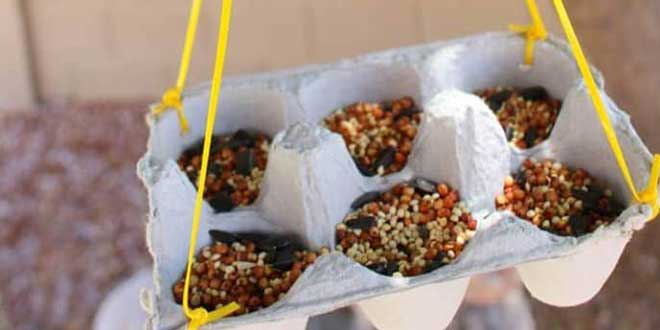Attracting the widest variety of birds to your backyard can be a fun learning experience. All it takes is a basic understanding of the different types of birdfeeders and a little creativity.
Here are two types of easy-to-make bird feeders to attract birds. This activity will require tools and some cutting; therefore, adult supervision for building feeders is highly recommended.
PLATFORM FEEDERS – Platform feeders can be hung two to six feet above the ground. These feeders attract the widest variety of birds from small perching birds to larger ground-feeding birds. You can make your own inexpensive platform feeder by using empty egg cartons and twine.
INSTRUCTIONS:
- Take an empty one-dozen egg carton and cut off the cover. Then cut the bottom of the carton where the eggs are placed into three four-cup feeders or two six-cup feeders. Use a nail to poke a hole in the top of each corner of the feeder.
- Cut four pieces of twine of equal length and attach each piece to a corner of the feeder by threading the twine through the hole and then tying a knot. Then, tie the other end of each of the four pieces of twine together so the feeder can be hung a few feet above the ground.
- Pour bird seed into the cups and hang in an open area, preferably near trees or shrubs where birds can perch, will feel safe and can fly into quickly if alarmed.
HANGING FEEDERS – Turn an ordinary plastic bottle into a functional bird feeder. These feeders are simple and inexpensive to make and they work very well. The most common bottles used are two-liter soda bottles, but just about any size of plastic bottle works well. For perches, you can use woodworking dowels, unsharpened pencils, chopsticks, twigs or small sticks.
INSTRUCTIONS:
- Clean and dry the bottle thoroughly, removing any labels. Use a weak bleach solution to be sure the bottle is sanitized, then rinse thoroughly. Allow the bottle to air dry for several hours.
- Screw a metal screw hook into the center of the bottle’s cap, making sure it is firm and tight. If necessary, you can use an awl or nail to start the hole, which will make it easier to screw in the hook.
- After the hook is fully inserted, seal both sides of the cap where the hook was placed (inside and out) with a drop of polyurethane glue to keep moisture out of the feeder. Avoid getting glue on the bottle cap’s threads; you will need to open the bottle whenever you refill it with seeds.
- Cut holes large enough to fit the perches completely through the bottle, about 1 1/2 inches from the bottom of the bottle. The perch dowels should fit snugly into the holes and extend completely across the bottle and out the matching hole on the opposite side. Balance the length of the perch on each end to allow birds to feed comfortably.
- Additional perches can be placed higher on the bottle. Each additional perch should be two to three inches higher than the last and rotated around the bottle from where the last perch was located. This creates the most space for birds to perch. The top perch should be three to four inches below the cap.
- Cut feeding ports one to two inches above each perch, using a utility knife. The ports should be 1/8 to 1/4 inch wide. Oval-shaped holes that are taller than they are wide will be easier for birds to feed on.
- Slowly fill the feeder with the desired seed. Hang the feeder outside from a tree branch or other support structure and wait for birds to discover it.
After the birds start to feed at your feeders, use a free online birding app such as Audubon birding app to keep track of the different birds your feeders will attract.
The Department strongly recommends that bird feeders not be utilized in areas with high bear activity and that feeders be taken down daily in other areas during crepuscular (twilight) and night time hours when bears are active or not hibernating.
 New Mexico Wildlife magazine Conserving New Mexico's Wildlife for Future Generations
New Mexico Wildlife magazine Conserving New Mexico's Wildlife for Future Generations
